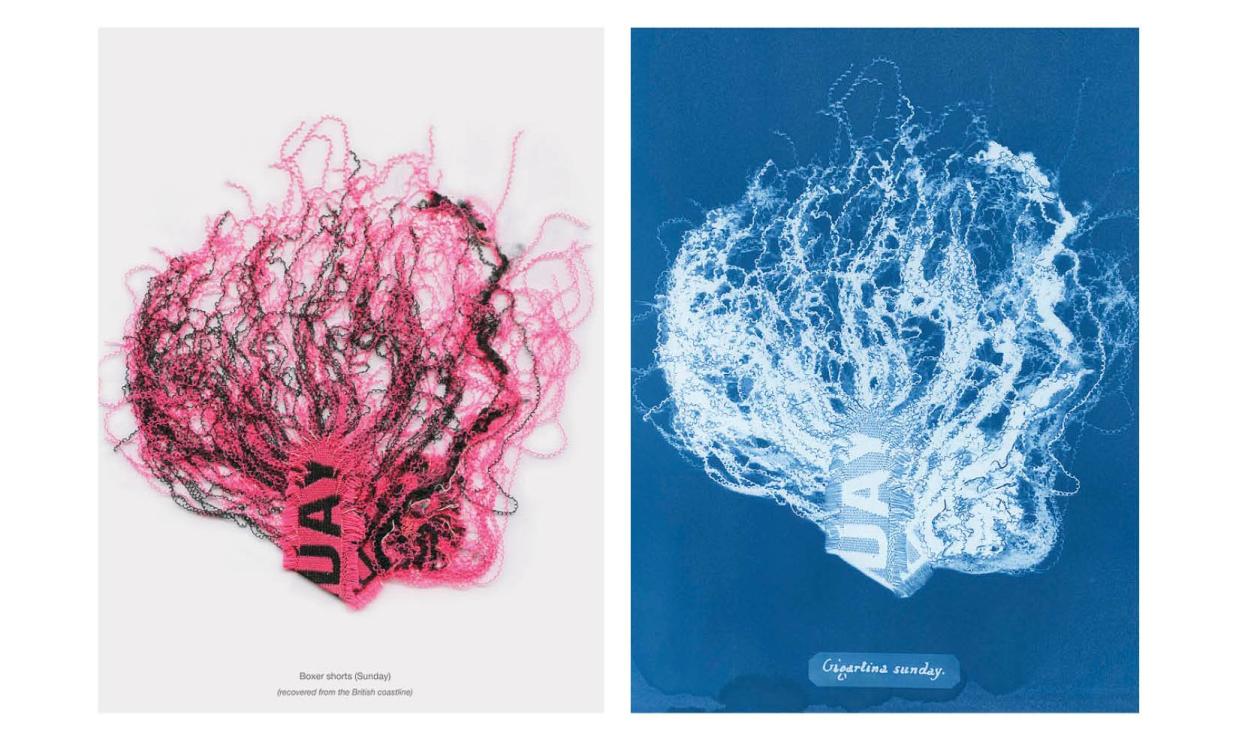‘People are anaesthetised to seeing rubbish everywhere’: the book unearthing waste in our seas

When Mandy Barker stumbled upon a fragment of colour in a rock pool while walking near Spurn Point, East Yorkshire, in 2012, she was bewitched. “I thought it was a piece of seaweed with lovely colours on it – greeny-browny – but when I went to pick it out, I saw that it was actually a strip of clothing material,” she says.
Growing up on the Yorkshire coast, Barker had become used to the coastline she once walked to collect driftwood shells changing around her. “Over the years I saw TVs, fridge freezers and computers washing up on the beach,” she said. “Fishers there told me they could see trawlers out at sea visibly dumping waste into the ocean. People would pay these trawlermen to take their rubbish out and dump it. And the fish were getting tangled up in it.”
Barker’s award-winning photography has focused on the sometimes ambiguous beauty of this plastic debris – but even so, she says she was “shocked at the way [the fabric] mimicked seaweed so well that I took it home and put it on a shelf in my studio”. Through online research, she identified the material as a piece of a polyester garment. “Ironically, my mum used to have a very similar blouse in the 70s,” she says.
The discovery began a 10-year journey that took the Hull-born artist around the British coastline collecting eerie shards of discarded clothing. That journey ends with the launch of an innovative, brilliant and ecologically subversive recreation of the world’s first ever photographically illustrated book, Photographs of British Algae: Cyanotype Impressions by Anna Atkins. The launch date, 16 March, was chosen to mark Atkins’s birthday.
Atkins’s pioneering work curated ghostly images of algae shapes on cyanotype, a monochrome blueprint created on a near-ultraviolet-to-blue light spectrum. Published in 1843, only 17 copies of the book – in varied forms of completion – are thought to remain.
Barker says that when she discovered the book at the Royal Society “I realised that that was the project I’d use [the fabric] for. She had written about seaweed and I had all these seaweed-like pieces of cloth and I thought: ‘That’s what I’m going to do.’”
Women were underrepresented in publishing in the mid-1800s and Atkins self-published her book using the initials “AA”, which were assumed to mean “anonymous amateur” until the 1970s. “She made these amazing books but no one gave her any credit,” says Barker.
She tracked down the same paper, watermarked J Whatman, that Atkins had used. She traced over Atkins’s alphabet to create the same feathery handwriting, although she had to replace the Latin names of algae in Atkins’s captions, with Latin approximations of the garment types she had found.
More than 200 images of her fabric strips, some still with coral, snails and shell fragments attached, were scanned to create negatives from which cyanotypes were made. In the end, Barker got so fixated with creating an exact replica of the 19th-century classic that a former college tutor sent her a message warning her to “Remember that you are Mandy Barker and not Anna Atkins”.
Underwriting the project was a sense of a polluting fast fashion juggernaut speeding out of control. With fewer than 1% of clothes currently being recycled, countries such as Kenya annually receive around 450m items of waste clothing a year, much of it destined for disposal in landfill sites.
Cheap, stylish but low-quality garments from household names such as Zara, Nike and Adidas were found to begin disintegrating almost immediately after purchase in one study, losing more than 100mg of fibres for every kilo of laundry. More than one third of primary microplastics released into the environment come from laundered synthetic clothes. From there they pollute every part of the planet, including our bodies, and even clouds.
Polyester makes up the vast majority of synthetic fibre production – and huge amounts of fossil fuels are needed to make it. Fast fashion consumes more oil than the country of Spain, and oil majors are betting that there’s more space yet in the world’s collective wardrobe. BP’s energy scenario assumes that 95% of future oil demand growth will come from plastics production. The fashion industry already has a bigger carbon footprint than the maritime and aviation sectors put together. It is also estimated to cause 20% of global freshwater pollution.
Barker monitors it all from the sidelines – and the coastlines. “I’m not a particularly fashionable person,” she says. “I buy pieces of clothing and keep them for years. I still have clothing that I bought 25 years ago and I’m not buying any clothes at all this year, just to make a statement. I don’t find that difficult.”
Her project is aimed in the first instance at generation Z and millennials “because I think older people are generally happy with the woolly jumper they’ve had for 30 years, as I am”. As the growth of vintage stores, secondhand sales and community clothes markets begins to change fashion’s rules, Barker pins her hopes on a shift to more expensive, but better-quality and longer-lasting apparel.
One cyanotype in her book, of an M&S St Michael clothing logo – which was discontinued in 2000 – was included “to show how long that could have been in the ocean”, Barker says. “The intention is to make people think about how it hasn’t really degraded that much.”
In earlier attempts to photograph shoreline debris, Barker found that “people weren’t interested. They get anaesthetised to seeing rubbish everywhere and they just switch off. So I realised that I had to create something different. If using ambiguity in this way helps to draw people in and read about what it represents, then I’ve won.”
Mandy Barker’s Photographs of British Algae: Cyanotype Imperfections can be seen at atkins-barker.com


